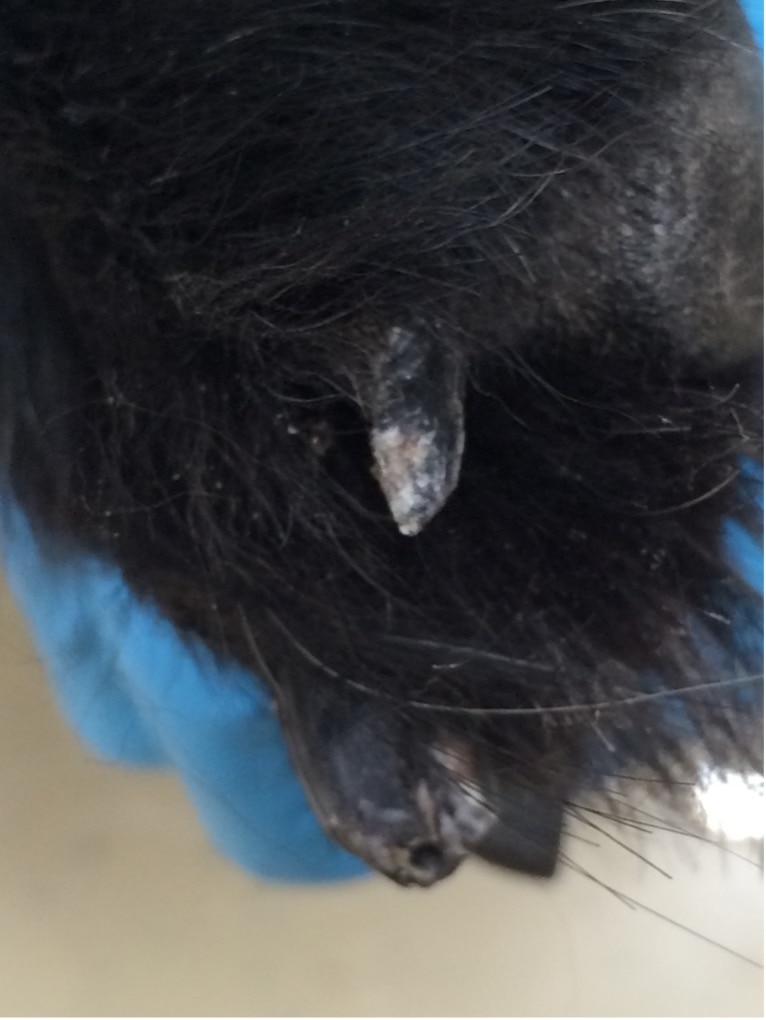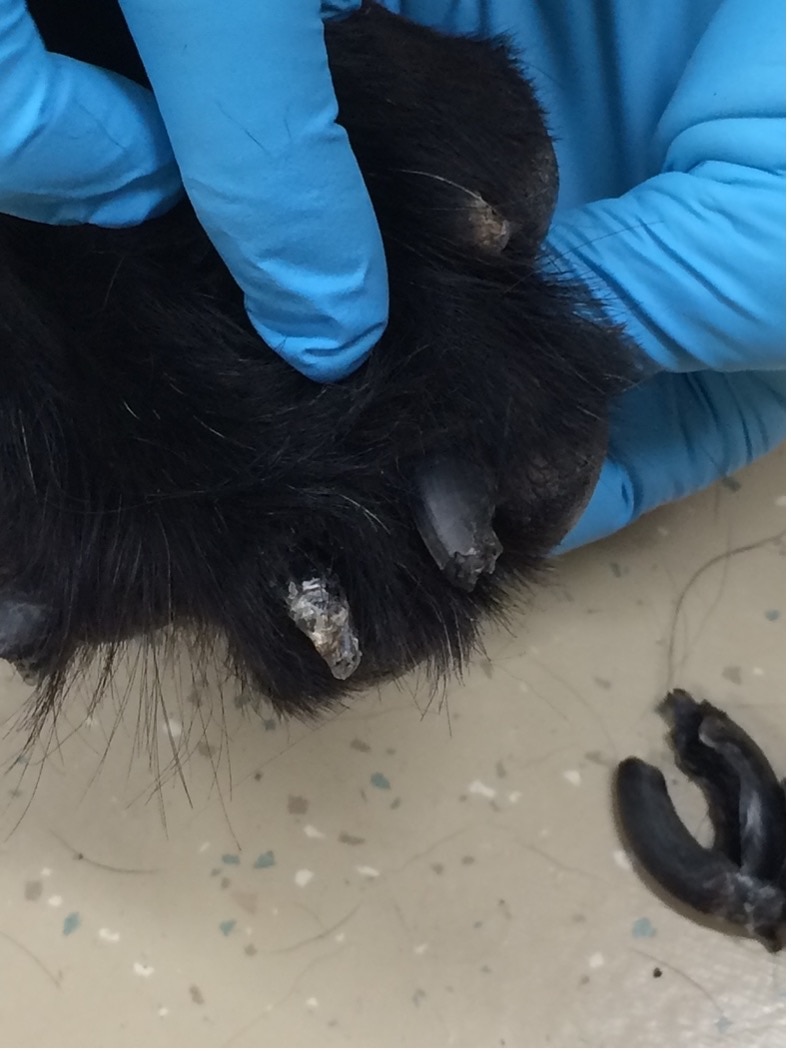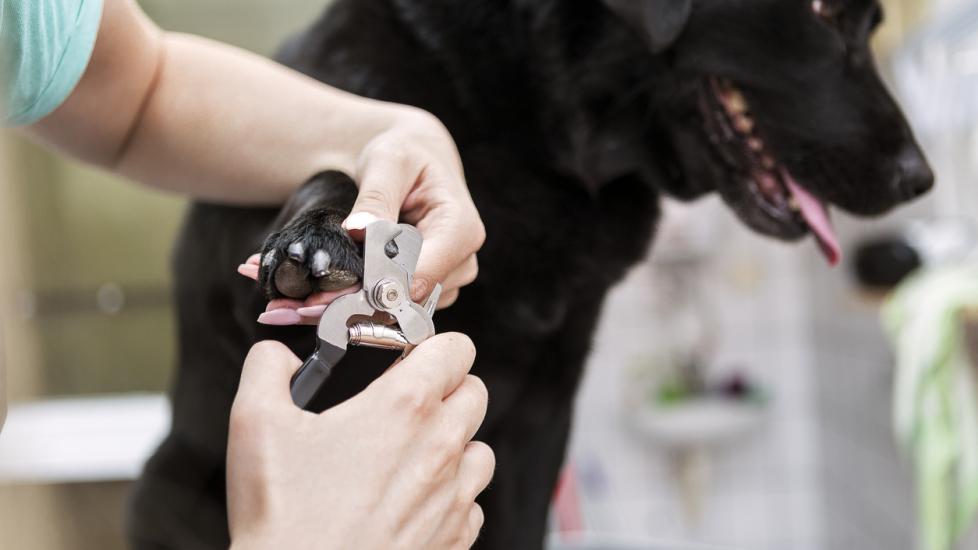Lupoid Onychodystrophy in Dogs
What Is Lupoid Onychodystrophy in Dogs?
Lupoid onychodystrophy, or symmetrical lupoid onychitis (SLO), is an uncommon medical condition that affects a dog’s toenails.
It usually starts and progresses quickly, involving all four feet and multiple nails. The nails will get dry and brittle, crack, split, and eventually become deformed. The nails may even fall off. If one falls off, it leaves the “quick” (normally the pink or black area at the nailbed) exposed, which causes pain and possibly a secondary infection.

Lupoid onychodystrophy seen on a dog’s nail.
(Photo credit: Autumn Madden, DVM)
This uncomfortable disease will cause your dog to lick their feet frequently and/or have trouble walking. Although this disease process is not completely understood, it is likely triggered by an overactive immune system and is not a contagious condition.
It is also understood to be a genetic condition inherited from one or both of a dog’s parents. Often the changes to the nails are noted in young to middle-aged dogs between 2–8 years old, but they are also seen in puppies and senior dogs. German Shepherds, Rottweilers, and Gordon Setters represent the most common breeds to develop lupoid onychodystrophy.
The condition should be treated as soon as possible to control any infection. If you notice any abnormalities in your pet’s toenails, or that they are licking their paws excessively, take them to the veterinarian for an exam.
Symptoms of Lupoid Onychodystrophy in Dogs
The nail problem begins in the nailbed and causes abnormal nail development. Often the first signs noted are secondary to pain—excessive foot or paw licking at the nails, or limping and lameness. The nail will then lift up off the nailbed, fall off, and leave the sensitive tissue underneath exposed. Typically, one or two nails are lost first, followed by shedding of all nails within weeks or months. Due to the pain caused by this condition, your dog will likely be reluctant to have its feet examined. Dogs affected with SLO will be otherwise healthy, although some cases have been reported to cause enlarged lymph nodes (lymphadenopathy).
Nail bed infections can occur secondary to this disease and make the toes red and swollen, with an odor or discharge. This infection is often from the exposed nail bed encountering bacteria from the ground.
Nails will quickly be:
-
Split or cracked
-
Brittle
-
Thickened
-
Deformed
-
Have pus and/or blood beneath
-
Have abnormal curvature

Lupoid onychodystrophy affecting a dog’s nail, causing nail to fall off and exposing nail bed.
(Photo credit: Autumn Madden, DVM).
Causes of Lupoid Onychodystrophy in Dogs
The exact cause of lupoid onychodystrophy in dogs is unknown, but it is suspected to be an immune-mediated disease condition with a genetic component. SLO is the most common immune-mediated disease that results in abnormal nails, and eventually nail loss.
How Veterinarians Diagnose Lupoid Onychodystrophy in Dogs
Your veterinarian might be able to make a presumptive diagnosis of SLO due to the appearance of the toenails and your dog’s history. But they may first seek to rule out other causes, such as a bacterial or yeast infection, ringworm, and some cancers.
A culture of the affected nail can rule out bacteria, fungus, or ringworm. X-rays should also be done to ensure that the underlying bone is healthy and no evidence of cancer is seen. Ultimately, a biopsy of the nailbed or a fine needle aspirate can be done to look at the cells (a process known as histopathology or cytology).
Depending on the severity of the nail bed lesion, sometimes a digit amputation at the dewclaw is performed for biopsy. The nail that falls off will not provide a diagnosis; the nailbed is needed for it. These test results should confirm a diagnosis of SLO if your dog is affected.
Treatment of Lupoid Onychodystrophy in Dogs
There are several treatment options for dogs affected with SLO. Unfortunately, no single treatment protocol has been established for treating this uncommon condition. The mainstay of treatment is aimed at suppressing the immune system. It often takes six to 12 weeks for the toenails to start to improve. The medications may initially need to be adjusted, but the one your vet finds the most effective for treatment is usually for life.
Common medications, supplements, and treatments prescribed or recommended include:
-
Fatty acids—specifically EPA and DHA commonly found in fish oils, which are a cornerstone of treatment
-
Cyclosporine, Azathioprine—immune suppressants
-
Prednisone (or other corticosteroids)—used for severe cases initially, but not prescribed long-term
-
Pentoxifylline—suppresses inflammatory reactions
-
Vitamin E
-
Tetracycline or Doxycycline combined with niacinamide (vitamin B3)
-
Frequent nail trims
-
Antibiotics for secondary bacterial infections
More aggressive treatment for severe or recurrent cases of SLO include onychectomy, which is surgical removal of the toe tip, often done with a laser or a scalpel blade. This surgical procedure is not commonly done unless there is significant unmanageable pain and deformity of the nail bed.
Recovery and Management of Lupoid Onychodystrophy in Dogs
Overall prognosis once SLO is treated is good, but nails may continue to break easily and remain deformed. It can take three to four months to see a clinical improvement with successful therapy.
It is important to give all medications and supplements as prescribed by your veterinarian. Do not discontinue any without their approval, even if you believe it is not helping, because a relapse can occur.
Frequent nail trims are very important and should be done every one to two weeks for the rest of your dog’s life. In some cases, your veterinarian may taper the medications after six months of successful treatment, but they are usually required for life. It’s beneficial to keep your dog’s paws and toes clean and dry at all times, and to use a medicated wipe after walks outdoors. Diets enhanced with fatty acids, such as Purina Pro Plan for Sensitive Skin & Stomach and Hill's Science Diet, are recommended if your dog will not easily take a supplement or if they need additional sources.
Featured Image: iStock.com/Nastasic
Help us make PetMD better
Was this article helpful?
